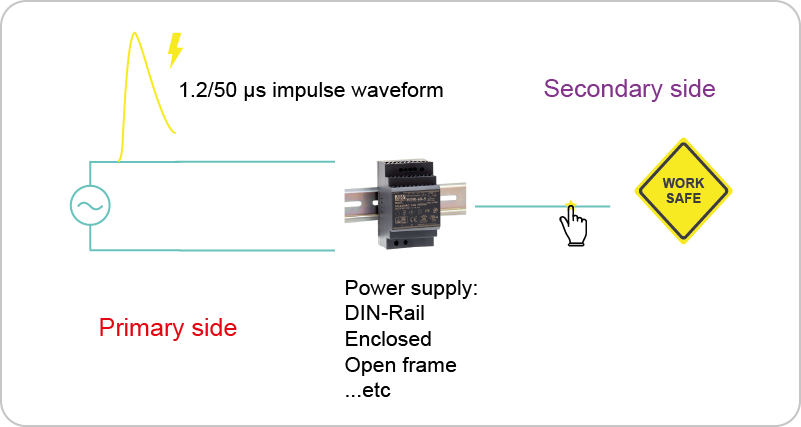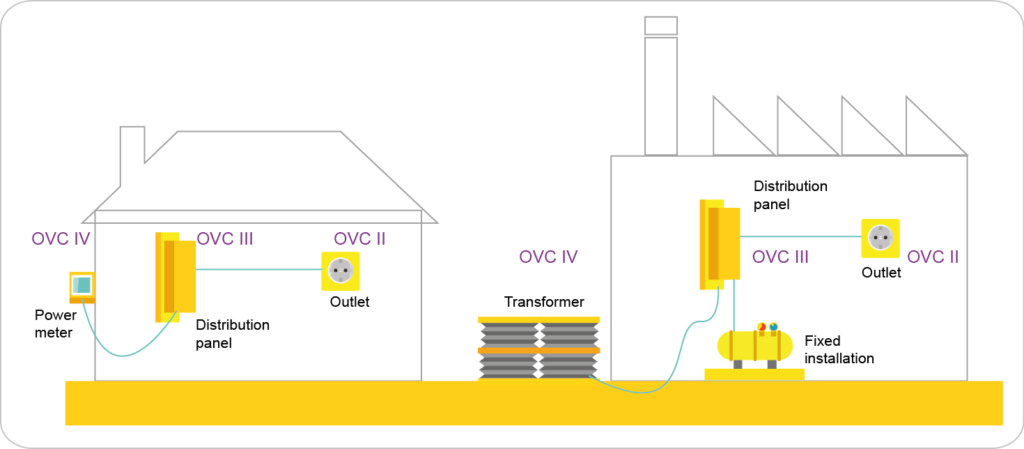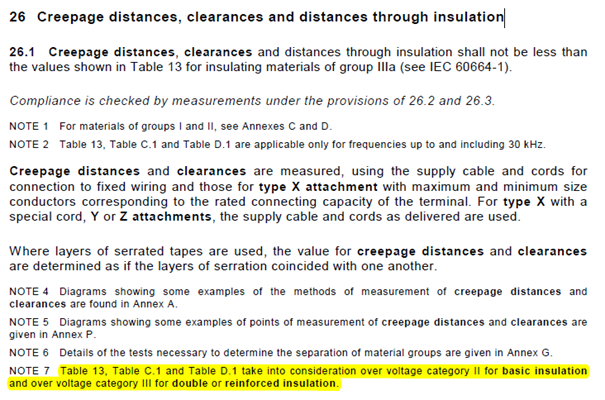Power Supplies for Overvoltage Category (OVC) III Applications
Introduction
The concept of overvoltage categories is used for equipment energized directly from the low-voltage (<1000Vac) mains. A similar concept can also be used for equipment connected to other systems, for example telecommunication and data systems. The overvoltage category (OVC) specifies a transient overvoltage level from such as lightning or unstable power to determine the location where the electrical equipment or power supply is installed. It is used to ensure that the defined transient voltage from the primary side does not pass through the secondary side at which the safety is still maintained at a sufficient level as shown in Figure 1. The power supply of MEAN WELL is used to design based on OVC II of EN60950 safety standard. Recently there are more and more demands on OVC III from various applications for instance industrial control and building automation. As result this article discuss what power supply is available for selection and the reasons behind it.

Figure1: Overvoltage category to provide the level of safety
Overvoltage category classification
According to IEC 60664-1(2007) Insulation coordination for equipment within low-voltage systems – Part 1: Principles, requirements and tests:
Equipment of Overvoltage Category I (OVC I)
is equipment for connection to circuits in which measures are taken to limit transient or short duration overvoltage to an appropriately low level. These measures should ensure that the temporary overvoltage that could occur are sufficiently limited so that their peak value does not exceed the relevant rated impulse voltage of Table 1. The typical application is equipment containing electronic circuits protected to this level. Unless the circuits are designed to take the temporary overvoltage into account, equipment of OVC I cannot be directly connected to the supply mains.
Equipment of Overvoltage Category II (OVC II)
is energy-consuming equipment to be supplied from the fixed installation. The typical application is appliances, portable tools and other household similar loads. The OVC II is basically connected to the mains plug or socket at home or factory shown in the Figure 2. If such equipment is subjected to special requirements with regard to reliability and availability, overvoltage category III should be applied.
Equipment of Overvoltage Category III (OVC III)
is equipment in fixed installations and for cases where the reliability and the availability of the equipment is subject to special requirements. The typical application is switch(es) in the fixed installation and equipment for industrial use with permanent connection to the fixed installation.
Equipment of Overvoltage Category IV (OVC IV)
is for use at the origin of the installation. The typical application is electricity meter(s) and primary overcurrent protection equipment.
Table 1 shows the rated transient overvoltage or impulse voltage level for OVC III is 4000V considering the 230Vac mains in Europe while the level for same category is just 2500V in North America where the mains is 120Vac. It reveals the power supply under same class overvoltage category that meets European standard can comply with North America provided stricter impulse voltage level is applied. It is worth to clarify here that the rated impulse voltage is not the withstand or dielectric voltage specified in the datasheet of power supply although there is a √2 mathematical relationship between them that is 4000V rated impulse voltage is equal to 2800V withstand voltage. Table 1 shows only the level for basic insulation. In case the power supply is designed to double or reinforced insulation, the voltage should consider one level higher. Moreover, the power supply with OVC III is downward compatible with OVC II, I application and environment.
| Voltage line to neutral derived from nominal voltage AC or DC up to and including (V) | Rated impulse voltage (V) | |||
| Overvoltage category | ||||
| I | II | III | IV | |
| 50 | 330 | 500 | 800 | 1500 |
| 100 | 500 | 800 | 1500 | 2500 |
| 150 | 800 | 1500 | 2500 | 4000 |
| 300 | 1500 | 2500 | 4000 | 6000 |
| 600 | 2500 | 4000 | 6000 | 8000 |
| 1000 | 4000 | 6000 | 8000 | 12000 |
Table 1 Rated impulse voltage for equipment energized directly from the low-voltage mains (IEC 60664-1)

Figure 2 Over voltage category(OVC) illustration
OVC III power supply applications
With recent emerging demands for industrial 4.0, some robot controller products to meet the IEC60204-1 standard need an additional AC transformer in series between the power grid and power supply as shown in Figure 3.

Figure 3 OVC II or III grade power supply applied for robot application
However, if the power supply itself can meet the OVC III requirement, then the AC transformer can be removed while the system still complies with IEC60204-1 requirements which not only saves the space and weight in the system, but also reduce the overall cost of the product to further increase competitiveness of final product.
Another application for the OVC III power supply is to be used for industrial equipment or permanently connected to the fixed installation of equipment.
Some other norms/standards driving by applications requiring OVC III are:
| Name | |
| IEC/EN50178 | Electronic equipment for use in power installations |
| IEC 60204-1 | Safety of machinery – Electrical equipment of machines – Part 1: General requirements |
| IEC 62103 | Electronic equipment for use in power installations (replaced by IEC 62477-1) |
| IEC/EN62477-1 | Safety requirements for power electronic converter systems and equipment – Part 1: General |
Power supply selection complies with OVC III from MEAN WELL
MEAN WELL offers a wide selection of OVC III power supply that have been certified with EN61558-1 though the current CB report has not been directly stated. According to the current version of standard IEC 61558-1: 2005 + AMD1: 2009, it has written that the creepage distance, clearance distance and distance through insulation is specified based on OVC III requirement in case the power supply has double or reinforced insulation between primary and secondary quoted in Figure 4. Next version (third edition) of IEC 61558-1 will clearly specify the OVC test difference among categories to improve the information provide by current release of standard. Nevertheless, it is obvious that power supply with EN61558 safety approval comply with OVC III requirements according to the current norm.

Figure 4 Power supply with double or reinforced between primary and secondary will meet OVC III design according to the text quoted from IEC 61558-1:2009 edition 2.1
The product family has obtained EN61558-1 approval are: LRS-35/50/75/100/150/150F, RSP-75/100/150, HDR-15/30/60/100, KNX-20E, OWA series. The product specification is changed and added to show information about OVC III as shown in the Figure 5. OWA series has no change on the product specification is because they are designed as finished product with AC plug. Hence the OVC II application is generally sufficient.

Figure 5 Updated specification for power supply meeting OVC III
Updated product specification indicates that the power supply meets the requirements of OVC III for a height up to 2000m whereas it is back to OVC II in case of above 2000m. Although the product has reserved the enough clearance distance for 5000m (1.48 factor larger than 2000m one), but the product also needs to be subjected to the corresponding impulse voltage test according to IEC61558. The maximum test voltage under OVC III is given and tested only to 2000m and the norm does not specify the test voltage over 2000m. As result, it is required to reduce to OVC II (lower test pulse voltage) when operating the power supply beyond 2000m so that the corresponding required impulse voltage will never exceed the actual tested impulse voltage due to altitude weighting.
OVC II power supply for OVC III application
How can the power supply without EN61558-1 safety certificate be used in OVC III application? There are two solutions: 1) Use an AC transformer in front of OVC II power supply in order to increase the corresponding distances; 2) Use an appropriate surge absorber/protector. For example, take the Type 2/3* surge protector in front to control the input impulse voltage level so that the subsequent can have OVC II power supply. Although both solutions will increase the cost and space, nevertheless it could still be an acceptable solution under system consideration.
* Details about selection of surge protector can be found from the Internet
Conclusion
The power supply designed according to EN61558-1 safety regulations is suitable for OVC III applications. Compared with previous solution, the benefit of using OVC III power supply is that the size and cost of the final system can be further reduced and thus increase market competitiveness. Current OVC III product range is: LRS-35/50/75/100/150/150F, RSP-75/100/150, HDR-15/30/60/100, KNX-20E, OWA series (though not shown with updated specification). In the meanwhile, MEAN WELL will continue to ensure the compliance with OVC III design for newly developed products to increase the level of system integration and offer wide selection of products in the standard power supply industry.
About the author Wen Wu
Wen Wu received the M.E. and Ph.D. degrees from Delft University of Technology, The Netherlands in 2012. Since then, he has been with MEAN WELL Europe B.V. located in Amstelveen, where he involves in technical consulting, in-house / field training, certification approvals and products planning. He is currently responsible for product research & development for for the European market.
Located in Amstelveen, The Netherlands, MEAN WELL Europe B.V. has an engineer team, R&D center, as well as a warehouse to provide European customers with the best local technical, sales and logistic support. For more information, please visit www.meanwell.eu.